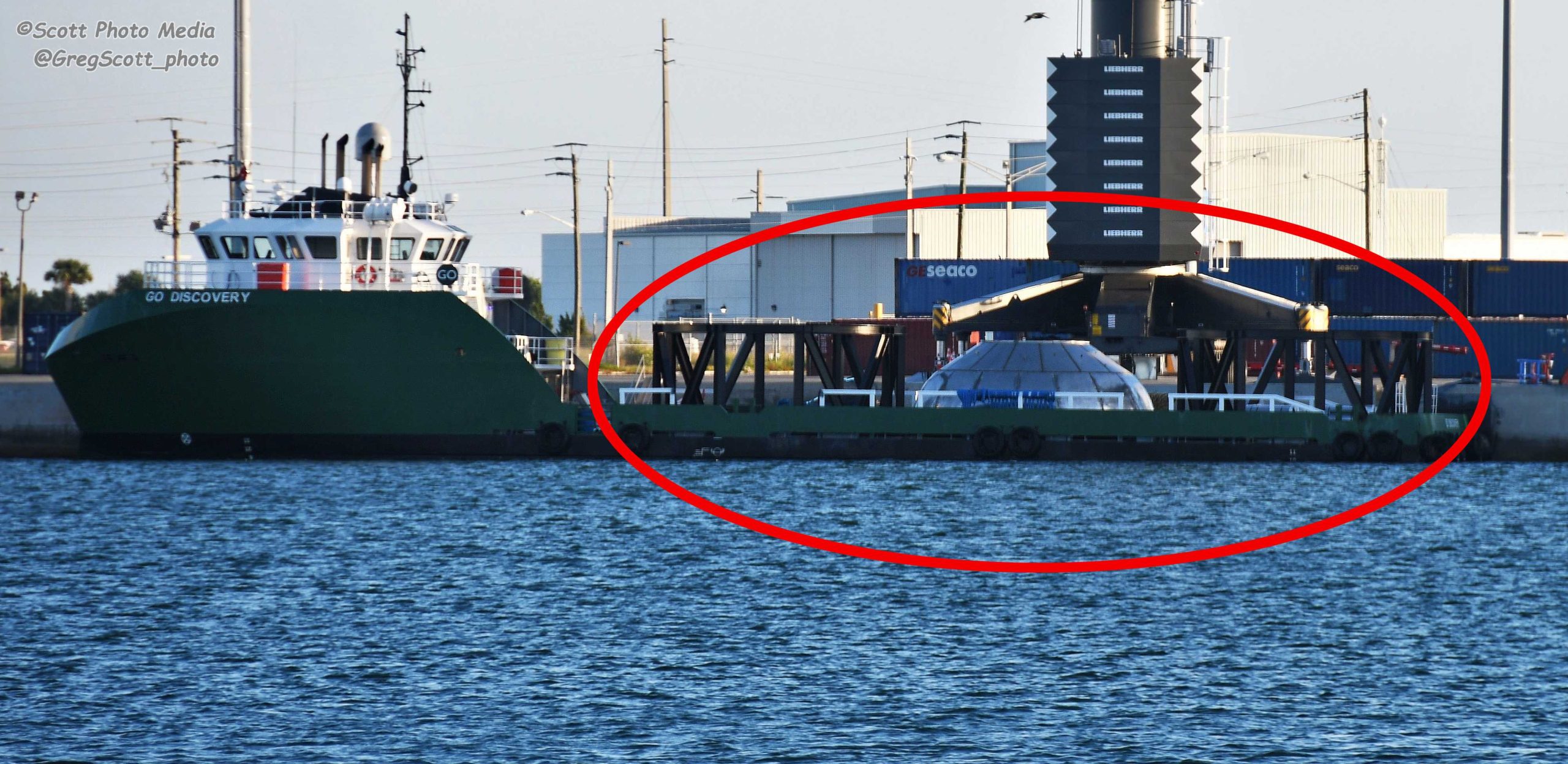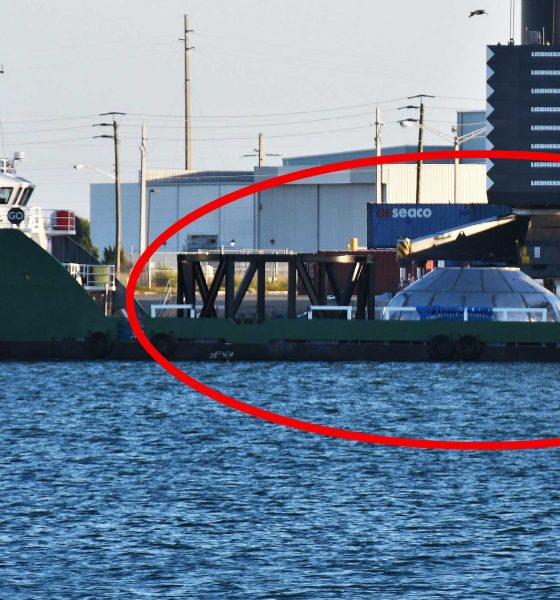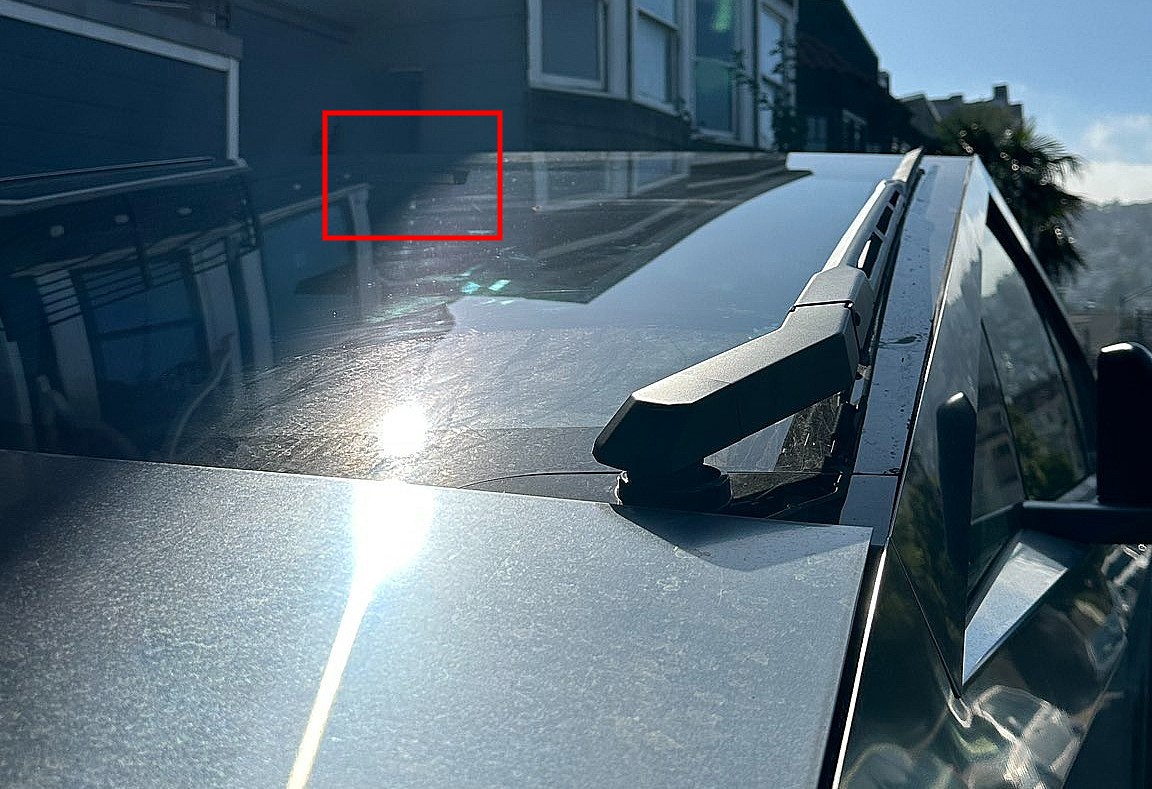

News
SpaceX Starship hardware mystery solved amid reports of Florida factory upheaval
A SpaceX Starship hardware mystery has been effectively solved after rocket parts arrived at Port Canaveral and were loaded aboard a transport ship, seemingly preparing for an unexpected journey by sea.
In an unexpected turn of events, SpaceX appears to be preparing to ship major Starship hardware from its Cocoa, Florida facility to a similar worksite in Boca Chica, Texas. Spotted for the first time in a photo taken by local photographer Greg Scott on November 30th, that hardware – at least two large stands and a nearly-complete steel tank dome – abruptly appeared beside SpaceX’s Port Canaveral dock space.
Seemingly within hours of their appearance, new vessel GO Discovery also arrived in Port Canaveral and parked by the same SpaceX docks. Shortly thereafter, workers loaded her with both build stands and a Starship tank dome and secured the surprise cargo. As it turns out, another local SpaceX-follower and prolific photographer/videographer happened to capture the disappearance of both stands and dome from SpaceX’s nearby Cocoa, FL Starship construction facility, where Starship Mk2 and Starship Mk4 were being built.
This neatly ties up the minor mystery of where that hardware went: SpaceX clearly moved all three parts to Port Canaveral, where they have since been loaded on a small supply ship. Two main questions remain, however: why have they been moved to the port and where are they headed?
The band is breaking up
Unfortunately, it appears that both questions can effectively be answered by a report published by YouTube channel “What about it?!”. According to former Cocoa employee that spoke to reporter and channel creator Felix Schlang, SpaceX has reportedly transferred up to 80% of the Starship facility’s workforce to other groups in Florida and Texas. Instead of the friendly internal competition that pitted Cocoa against Boca Chica in the race to first Starship flight, SpaceX is temporarily slowing down its Florida build operations and will redirect as much of its workforce and resources as possible to Boca Chica.
According to Schlang’s source, this will likely result in several months of relative downtime in Florida, while he was also told that Starship Mk2 and Mk4 are now effectively dead before arrival as a result of several challenging and reoccurring technical issues. Starship Mk2 likely shares some significant heritage with Starship Mk1, which lost its top during a pressure test. Roughly two-dozen steel Starship Mk4 rings may also be scrapped after SpaceX’s Florida team could not overcome a technical hurdle. Per the source, many of those single-weld steel rings were slightly different diameters, making it next to impossible to build a sound pressure vessel (i.e. Starship Mk4) with them.
Combining the appearance of Starship hardware on GO Discovery just yesterday and reports of major Cocoa layoffs, it’s all but certain that the Starship components on Discovery are going to head to Boca Chica, Texas. Schlang’s source also indicated that all affected employees were given the option to transfer to Boca Chica or Hawthorne, a prime indication that this abrupt change in plans is more a strategic move than a financial one. With any luck, most affected employees will be able to transfer to Florida pad operations or Boca Chica, although such a major and abrupt change is likely a no-go for anyone with major ties to South Florida.
The Starship dome and stands now likely headed for Boca Chica were built over the course of a month or two in Florida, meaning that they were either built under the impression that they would support Boca Chica’s Starship Mk3 prototype or repurposed after SpaceX decided to pause work in Cocoa. Of note, something like 8-12 of Starship Mk4’s steel rings were able to be stacked and all of those double-rings are still present at SpaceX Cocoa, while a number of single rings were indeed scrapped over the last few weeks. A header tank was also reportedly removed from Starship Mk2’s more or less finished nose section. If any of that hardware is technically viable, there’s a good chance that they may also be shipped to Texas to expedite Starship Mk3 integration.
Ultimately, given how rapidly SpaceX makes and changes decisions, pausing work in Cocoa doesn’t come as much of a surprise. It’s also far from the end of SpaceX’s Florida Starship-building efforts – Schlang indicates that SpaceX will instead focus on a similar facility located within Kennedy Space Center, making the process of building Starships offsite and transporting to Launch Pad 39A far more viable.
With this latest surprise, it also appears that SpaceX is now laser-focused on getting Starship Mk3 ready for South Texas flight testing. Stay tuned for an update on a flurry of recent developments at SpaceX’s Boca Chica Starship facilities.
Check out Teslarati’s Marketplace! We offer Tesla accessories, including for the Tesla Cybertruck and Tesla Model 3.

News
Tesla aims to combat common Full Self-Driving problem with new patent
Tesla writes in the patent that its autonomous and semi-autonomous vehicles are heavily reliant on camera systems to navigate and interact with their environment.

Tesla is aiming to combat a common Full Self-Driving problem with a new patent.
One issue with Tesla’s vision-based approach is that sunlight glare can become a troublesome element of everyday travel. Full Self-Driving is certainly an amazing technology, but there are still things Tesla is aiming to figure out with its development.
Unfortunately, it is extremely difficult to get around this issue, and even humans need ways to combat it when they’re driving, as we commonly use sunglasses or sun visors to give us better visibility.
Cameras obviously do not have these ways to fight sunglare, but a new patent Tesla recently had published aims to fight this through a “glare shield.”
Tesla writes in the patent that its autonomous and semi-autonomous vehicles are heavily reliant on camera systems to navigate and interact with their environment.

The ability to see surroundings is crucial for accurate performance, and glare is one element of interference that has yet to be confronted.
Tesla described the patent, which will utilize “a textured surface composed of an array of micro-cones, or cone-shaped formations, which serve to scatter incident light in various directions, thereby reducing glare and improving camera vision.”

The patent was first spotted by Not a Tesla App.
The design of the micro-cones is the first element of the puzzle to fight the excess glare. The patent says they are “optimized in size, angle, and orientation to minimize Total Hemispherical Reflectance (THR) and reflection penalty, enhancing the camera’s ability to accurately interpret visual data.”
Additionally, there is an electromechanical system for dynamic orientation adjustment, which will allow the micro-cones to move based on the angle of external light sources.
This is not the only thing Tesla is mulling to resolve issues with sunlight glare, as it has also worked on two other ways to combat the problem. One thing the company has discussed is a direct photon count.
CEO Elon Musk said during the Q2 Earnings Call:
“We use an approach which is direct photon count. When you see a processed image, so the image that goes from the sort of photon counter — the silicon photon counter — that then goes through a digital signal processor or image signal processor, that’s normally what happens. And then the image that you see looks all washed out, because if you point the camera at the sun, the post-processing of the photon counting washes things out.”
Future Hardware iterations, like Hardware 5 and Hardware 6, could also integrate better solutions for the sunglare issue, such as neutral density filters or heated lenses, aiming to solve glare more effectively.
Elon Musk
Delaware Supreme Court reinstates Elon Musk’s 2018 Tesla CEO pay package
The unanimous decision criticized the prior total rescission as “improper and inequitable,” arguing that it left Musk uncompensated for six years of transformative leadership at Tesla.

The Delaware Supreme Court has overturned a lower court ruling, reinstating Elon Musk’s 2018 compensation package originally valued at $56 billion but now worth approximately $139 billion due to Tesla’s soaring stock price.
The unanimous decision criticized the prior total rescission as “improper and inequitable,” arguing that it left Musk uncompensated for six years of transformative leadership at Tesla. Musk quickly celebrated the outcome on X, stating that he felt “vindicated.” He also shared his gratitude to TSLA shareholders.
Delaware Supreme Court makes a decision
In a 49-page ruling Friday, the Delaware Supreme Court reversed Chancellor Kathaleen McCormick’s 2024 decision that voided the 2018 package over alleged board conflicts and inadequate shareholder disclosures. The high court acknowledged varying views on liability but agreed rescission was excessive, stating it “leaves Musk uncompensated for his time and efforts over a period of six years.”
The 2018 plan granted Musk options on about 304 million shares upon hitting aggressive milestones, all of which were achieved ahead of time. Shareholders overwhelmingly approved it initially in 2018 and ratified it once again in 2024 after the Delaware lower court struck it down. The case against Musk’s 2018 pay package was filed by plaintiff Richard Tornetta, who held just nine shares when the compensation plan was approved.
A hard-fought victory
As noted in a Reuters report, Tesla’s win avoids a potential $26 billion earnings hit from replacing the award at current prices. Tesla, now Texas-incorporated, had hedged with interim plans, including a November 2025 shareholder-approved package potentially worth $878 billion tied to Robotaxi and Optimus goals and other extremely aggressive operational milestones.
The saga surrounding Elon Musk’s 2018 pay package ultimately damaged Delaware’s corporate appeal, prompting a number of high-profile firms, such as Dropbox, Roblox, Trade Desk, and Coinbase, to follow Tesla’s exodus out of the state. What added more fuel to the issue was the fact that Tornetta’s legal team, following the lower court’s 2024 decision, demanded a fee request of more than $5.1 billion worth of TSLA stock, which was equal to an hourly rate of over $200,000.
Delaware Supreme Court Elon Musk 2018 Pay Package by Simon Alvarez
News
Tesla Cybercab tests are going on overdrive with production-ready units
Tesla is ramping its real-world tests of the Cybercab, with multiple sightings of the vehicle being reported across social media this week.

Tesla is ramping its real-world tests of the Cybercab, with multiple sightings of the autonomous two-seater being reported across social media this week. Based on videos of the vehicle that have been shared online, it appears that Cybercab tests are underway across multiple states.
Recent Cybercab sightings
Reports of Cybercab tests have ramped this week, with a vehicle that looked like a production-ready prototype being spotted at Apple’s Visitor Center in California. The vehicle in this sighting was interesting as it was equipped with a steering wheel. The vehicle also featured some changes to the design of its brake lights.
The Cybercab was also filmed testing at the Fremont factory’s test track, which also seemed to involve a vehicle that looked production-ready. This also seemed to be the case for a Cybercab that was spotted in Austin, Texas, which happened to be undergoing real-world tests. Overall, these sightings suggest that Cybercab testing is fully underway, and the vehicle is really moving towards production.
Production design all but finalized?
Recently, a near-production-ready Cybercab was showcased at Tesla’s Santana Row showroom in San Jose. The vehicle was equipped with frameless windows, dual windshield wipers, powered butterfly door struts, an extended front splitter, an updated lightbar, new wheel covers, and a license plate bracket. Interior updates include redesigned dash/door panels, refined seats with center cupholders, updated carpet, and what appeared to be improved legroom.
There seems to be a pretty good chance that the Cybercab’s design has been all but finalized, at least considering Elon Musk’s comments at the 2025 Annual Shareholder Meeting. During the event, Musk confirmed that the vehicle will enter production around April 2026, and its production targets will be quite ambitious.








